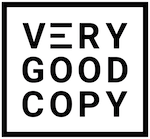
One of my articles received an interesting comment.
I’ll share the comment (268 words from now) but first, some background about the article:
It’s about how to use a technique called “dimensionalization” to arrive at the core benefit of a product or feature (the benefit your prospect ultimately desires, consciously or otherwise).

Never miss a VeryGoodCopy Micro-Article: SUBSCRIBE
A copywriter dimensionalizes by drilling, by identifying:
↓ the benefit
↓ of the benefit
↓ of the benefit, over and over.
And you drill by asking “So what?” again and again.
And it’s called “dimensionalization” because each time you drill down, you add dimension—specificity—to your benefit, making it deeper and more profound and, in turn, more compelling.
And through this process, you can turn a flat, surface-level benefit into something vivid and fundamental and irresistible, something that taps into your prospect’s very humanity.
In the article, I demonstrate dimensionalization with an example:

Now, the comment.
A marketer named Nick writes:
“How do you know once you’ve reached the bottom of the benefit rabbit hole? I feel everything could just get narrowed down to the simplicity of Maslow’s hierarchy of needs. When do you know you’ve reached the ‘productive’ bottom?”
Great question.
But what’s interesting is Nick actually answers it for himself. Because Maslow’s Hierarchy of Needs is, in fact, ~the goal~ of dimensionalization, as an ad ~should~ appeal to our foundational desires, to the things that make us uniquely human.
Drew Eric Whitman, direct marketer and author of the cult classic, Cashvertising, has his own name for this.
He calls it The Life-Force 8:
“Human beings,” writes Whitman, “are biologically programmed with the following eight desires…”
1. Survival, enjoyment of life, life extension.
2. Enjoyment of food and beverages.
3. Freedom from fear, pain, and danger.
4. Physical companionship.
5. Comfortable living conditions.
6. To be superior, winning, keeping up with the Joneses.
7. Care and protection of loved ones.
8. Social approval.
By creating ads that appeal to these things, you are tapping into Mother Nature, harnessing the power of our inborn motivators to compel and sell.
Hence the XL art print example:
Its physical size is an utterly superficial benefit compared to the psychological, intrinsic benefits of social approval and superiority. Therefore, the ad should tap into the latter, not the former.
“But Nick,” I replied, “Maslow’s hierarchy is everything.”
In advertising, when in doubt:
Align your benefits with the desires we're all born with.
“These powerful desires are responsible for more sales than all other human wants combined,” writes Whitman. “Learn them. Use them. Profit from them.”

LEARN TO PERSUADE
✅ Join thousands of email subscribers
✅ Less than 0.4% of readers unsubscribe
✅ Never miss a Micro-Article or -Interview
✅ Get instant email access to VGC's founder
✅ Be first in line to get new, free Micro-Courses
DRAYTON BIRD
Global Creative Director @ Ogilvy & Mather
BEN SETTLE
Email Marketing Master
KIM KRAUSE SCHWALM
A-List Direct Response Copywriter
RYAN BONNICI
Forbes 26th Most Influential CMO
SCOTT DIKKERS
Founding Editor @ The Onion 🧅
LISA PIERSON
Partner @ CopyHackers Agency
JUSTIN WELSH
SaaS Advisor & Writer
GODARD ABEL
CEO @ G2.com
DAVID GARFINKEL
A-List Direct Response Copywriter
JORGE SELVA
Director of Growth @ Help Scout
ADAM GOYETTE
Chief Marketing Officer @ Help Scout
TYLER J. KOENIG
Conversion Copywriter
TOMMY WALKER
Editor-in-Chief @ Shopify Plus & CXL
JASON VANA
Founder @ SHFT Marketing
JUSTIN BLACKMAN
Founder @ Pretty Fly Copy
CAMILLE TRENT
Managing Editor @ MarketerHire
NIKHIL NARAYANAN
Creative Director @ Ogilvy & Mather
EDEN BIDANI
Copywriter @ Greenlight Copy
MARK KILENS
VP of Content @ Drift
































